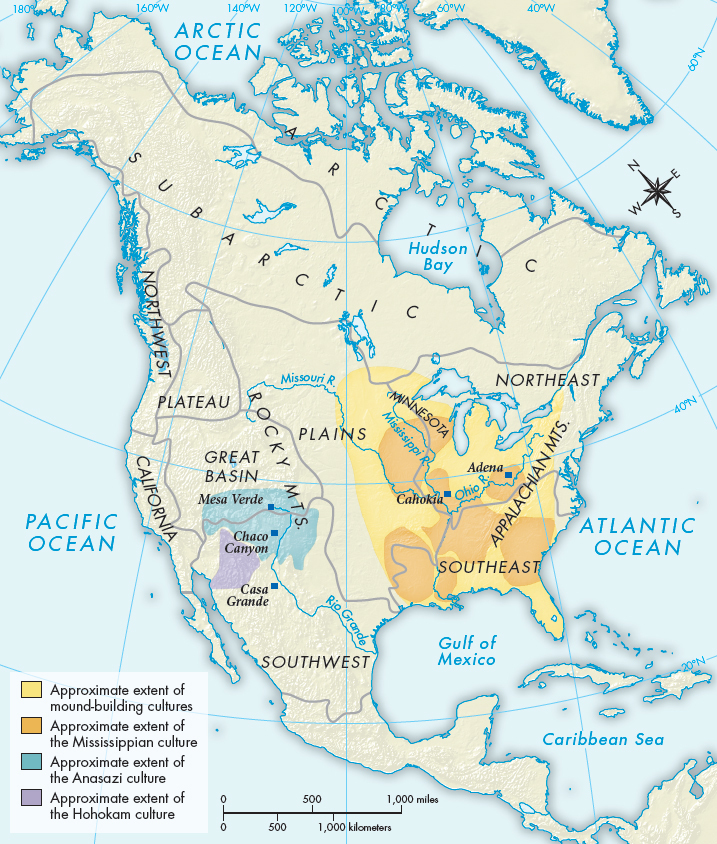Hohokam, Hopewell, and Mississippian Societies
Mesoamerican trading networks extended into southwestern North America, where by 300 B.C.E. the Hohokam people and other groups were using irrigation canals, dams, and terraces to enhance their farming of arid lands (Map 11.2). Like the Olmecs and other Mesoamerican peoples, the Hohokam built ceremonial platforms and played games with rubber balls that were traded over a long distance in return for turquoise and other precious stones. Along with trade goods came religious ideas, including the belief in local divinities who created, preserved, and destroyed. The Mesoamerican feathered serpent god became important to desert peoples. They planted desert crops such as agave, as well as cotton and maize that came from Mexico. Other groups, including the Anasazi (ah-nah-SAH-zee), the Yuma, and later the Pueblo and Hopi, also built settlements in this area using large sandstone blocks and masonry to construct thick-walled houses that offered protection from the heat. Mesa Verde, the largest Anasazi town, had a population of about twenty-five hundred living in houses built into and on cliff walls. Roads connected Mesa Verde to other Anasazi towns, allowing timber and other construction materials to be brought in more easily. Eventually drought, deforestation, and soil erosion led to decline in both the Hohokam and Anasazi cultures.

MAP 11.2 Major North American Agricultural Societies, ca. 600–1500C.E. Many North American groups used agriculture to increase the available food supply and allow greater population density and the development of urban centers. This map shows three of these cultures: the Mississippian, Anasazi, and Hohokam.
To the east, the Mississippian culture also engaged in monumental mound building beginning around 2000 B.C.E. One of the most important mound-building cultures was the Hopewell (200 B.C.E.–600 C.E.), named for a town in Ohio near the site of the most extensive mounds. Some mounds were burial chambers holding either a powerful individual or thousands of more average people. Other mounds formed animal or geometric figures. Hopewell earthworks also included canals that enabled trading networks to expand, bringing products from the Caribbean far into the interior. Those trading networks also carried maize, allowing more intensive agriculture to spread throughout the eastern woodlands of North America.
At Cahokia (kuh-HOE-kee-uh), near the confluence of the Mississippi and Missouri Rivers in Illinois, archaeologists have uncovered the largest mound of all, part of a ceremonial center and city that housed perhaps thirty-eight thousand people. Work on this complex of mounds, plazas, and houses — which covered 5½ square miles — began about 1050 C.E. and was completed about 1250 C.E. A fence of wooden posts surrounded the center of the complex. Several hundred rectangular mounds inside and outside the fence served as tombs and as the bases for temples and palaces. Within the fence, the largest mound rose in four stages to a height of one hundred feet and was nearly one thousand feet long. On its top stood a large building, used perhaps as a temple.
Cahokia engaged in long-distance trade reaching far across North America and became a highly stratified society. Mississippian mound builders relied on agriculture to support their complex cultures, and by the time Cahokia was built, maize agriculture had spread to the Atlantic coast. Particularly along riverbanks and the coastline, fields of maize, beans, and squash surrounded large, permanent villages containing many houses, all encompassed by walls made of earth and timber. Hunting and fishing provided animal protein, but the bulk of people’s food came from farming.
At its peak in about 1150 Cahokia was the largest city north of Mesoamerica. However, construction of the interior wooden fence stripped much of the surrounding countryside of trees, which made spring floods worse and eventually destroyed much of the city. An earthquake at the beginning of the thirteenth century furthered the destruction, and the city never recovered. The worsening climate of the fourteenth century, which brought famine to Europe, probably also contributed to Cahokia’s decline, and its population dispersed. Throughout Mississippian areas, the fifteenth century brought increased warfare and migration. Iroquois-speaking peoples in particular migrated into the region, sometimes displacing, through war, groups that had been living in these areas.
